(完整word版)Verilog-A30分钟快速入门教程.docx
- 格式:docx
- 大小:80.52 KB
- 文档页数:5
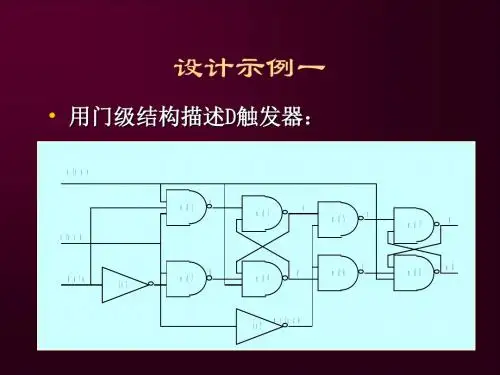

目录•Verilog概述•Verilog基础语法•组合逻辑电路设计•时序逻辑电路设计•数字系统设计方法学•华为Verilog编程规范与技巧Verilog概述1 2 3Verilog语言诞生,最初用于模拟电子系统的行为。
1980年代初期Verilog逐渐发展成为硬件描述语言(HDL),用于描述数字电路和系统的结构和行为。
1980年代中期Verilog不断完善和发展,成为电子设计自动化(EDA)领域的重要标准之一,广泛应用于集成电路设计、FPGA开发等领域。
1990年代至今Verilog历史与发展集成电路设计Verilog可用于描述数字集成电路的逻辑功能、时序关系和电路结构,是IC设计领域的重要工具。
FPGA开发Verilog可用于FPGA的逻辑设计和编程,实现复杂的数字系统和算法。
ASIC设计Verilog可用于ASIC设计的各个阶段,包括逻辑设计、综合、布局布线等。
系统级建模与仿真Verilog可用于构建系统级模型,进行系统仿真和性能分析。
Verilog应用领域01Verilog 是一种硬件描述语言(HDL ),用于描述数字电路和系统的结构和行为。
02与其他硬件描述语言(如VHDL )相比,Verilog具有更接近C 语言的语法风格,易于学习和使用。
Verilog 支持多种抽象层次的描述,包括行为级、寄存器传输级(RTL )、门级和开关级,方便设计师在不同设计阶段使用。
Verilog 与硬件描述语言关系02Verilog基础语法标识符与关键字标识符用于标识变量、模块、函数等程序实体的名称,由字母、数字和下划线组成,首字符必须是字母或下划线。
关键字Verilog语言中的保留字,用于定义语言结构和控制语句,如`module`、`input`、`output`、`if`、`else`等。
数据类型与运算符数据类型包括整型(`integer`)、实型(`real`)、时间型(`time`)以及用户自定义类型等。
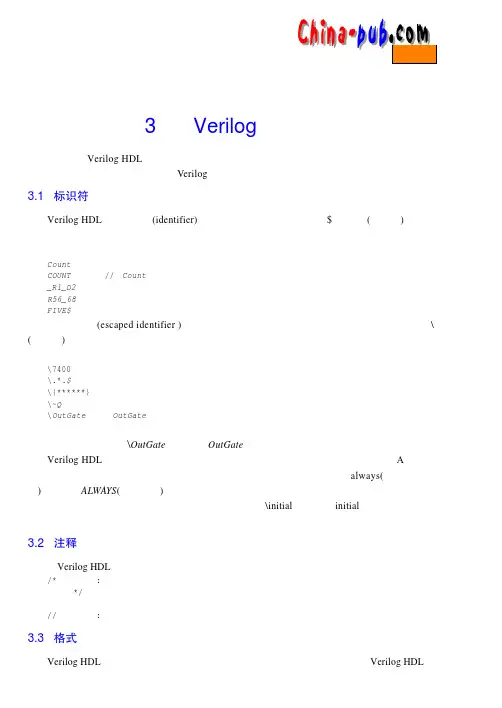
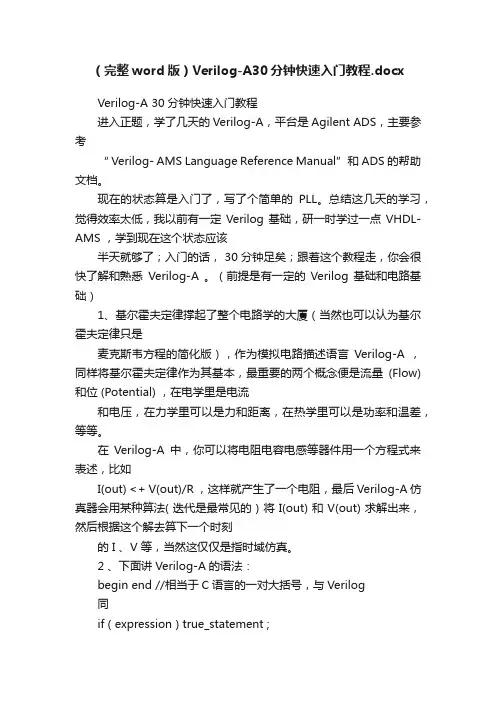
(完整word版)Verilog-A30分钟快速入门教程.docxVerilog-A 30分钟快速入门教程进入正题,学了几天的Verilog-A,平台是Agilent ADS,主要参考“ Verilog- AMS Language Reference Manual”和ADS的帮助文档。
现在的状态算是入门了,写了个简单的PLL。
总结这几天的学习,觉得效率太低,我以前有一定 Verilog 基础,研一时学过一点 VHDL-AMS ,学到现在这个状态应该半天就够了;入门的话, 30 分钟足矣;跟着这个教程走,你会很快了解和熟悉Verilog-A 。
(前提是有一定的Verilog 基础和电路基础)1、基尔霍夫定律撑起了整个电路学的大厦(当然也可以认为基尔霍夫定律只是麦克斯韦方程的简化版),作为模拟电路描述语言Verilog-A ,同样将基尔霍夫定律作为其基本,最重要的两个概念便是流量(Flow) 和位 (Potential) ,在电学里是电流和电压,在力学里可以是力和距离,在热学里可以是功率和温差,等等。
在Verilog-A中,你可以将电阻电容电感等器件用一个方程式来表述,比如I(out) <+ V(out)/R ,这样就产生了一个电阻,最后 Verilog-A 仿真器会用某种算法( 迭代是最常见的 ) 将 I(out) 和 V(out) 求解出来,然后根据这个解去算下一个时刻的 I 、V 等,当然这仅仅是指时域仿真。
2 、下面讲Verilog-A的语法:begin end //相当于C语言的一对大括号,与Verilog同if ( expression ) true_statement ;[ else false_statement ; ] //与Verilog同case ( expression ) case_item { case_item } endcasefor ( procedural_assignment ; expression;procedural_assignment ) statement//case与for语句都跟Verilog、C语言类似cross( expr [, dir [, time_tol [, expr_tol ]]] );//cross 用来产生一个 event ,如:@(cross(V(sample) -2.0, +1.0))//指 sample 的电压超过 2.0 时触发该事件,将会执行后面的语句,+1.0 表示正向越过, -1.0 则相反ddt( expr )// 求导,如:I(n1,n2) <+ C * ddt(V(n1, n2)); //表示了一个电容idt( expr ,[ ic [, assert [, abstol ]]] ) //积分,如:V(out) <+ gain * idt(V(in) ,0) + gain * V(in);// 比例积分,式中的 0 表示积分的初值transition( expr [, time_delay [, rise_time [, fall_time [, time_tol ]]]] )// 将 expr 的值 delay一下并指定上升下降沿时间,相当于一个传输门laplace_zp( expr ,ζ ,ρ)将expr 进行拉普拉斯变换,具体表达式参看相关文献,还有laplace_zd()等数据类型:integer 、real ,另外就是 discipline ,不知道怎么翻译比较好,比如说它将电压电流这两个nature 类型作为一个discipline ,这些都在disciplines.vams这个头文件里建好了,编程时要`include "disciplines.vams"。
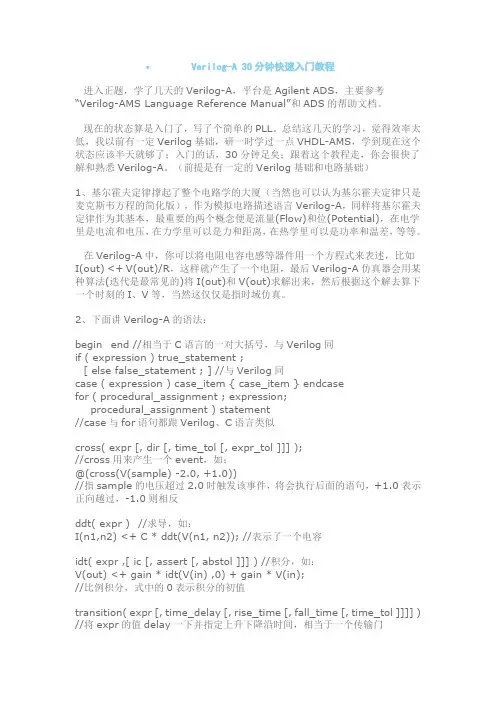
•Verilog-A 30分钟快速入门教程进入正题,学了几天的Verilog-A,平台是Agilent ADS,主要参考“Verilog-AMS Language Reference Manual”和ADS的帮助文档。
现在的状态算是入门了,写了个简单的PLL。
总结这几天的学习,觉得效率太低,我以前有一定Verilog基础,研一时学过一点VHDL-AMS,学到现在这个状态应该半天就够了;入门的话,30分钟足矣;跟着这个教程走,你会很快了解和熟悉Verilog-A。
(前提是有一定的Verilog基础和电路基础)1、基尔霍夫定律撑起了整个电路学的大厦(当然也可以认为基尔霍夫定律只是麦克斯韦方程的简化版),作为模拟电路描述语言Verilog-A,同样将基尔霍夫定律作为其基本,最重要的两个概念便是流量(Flow)和位(Potential),在电学里是电流和电压,在力学里可以是力和距离,在热学里可以是功率和温差,等等。
在Verilog-A中,你可以将电阻电容电感等器件用一个方程式来表述,比如I(out) <+ V(out)/R,这样就产生了一个电阻,最后Verilog-A仿真器会用某种算法(迭代是最常见的)将I(out)和V(out)求解出来,然后根据这个解去算下一个时刻的I、V等,当然这仅仅是指时域仿真。
2、下面讲Verilog-A的语法:begin end //相当于C语言的一对大括号,与Verilog同if ( expression ) true_statement ;[ else false_statement ; ] //与Verilog同case ( expression ) case_item { case_item } endcasefor ( procedural_assignment ; expression;procedural_assignment ) statement//case与for语句都跟Verilog、C语言类似cross( expr [, dir [, time_tol [, expr_tol ]]] );//cross用来产生一个event,如:@(cross(V(sample) -2.0, +1.0))//指sample的电压超过2.0时触发该事件,将会执行后面的语句,+1.0表示正向越过,-1.0则相反ddt( expr ) //求导,如:I(n1,n2) <+ C * ddt(V(n1, n2)); //表示了一个电容idt( expr ,[ ic [, assert [, abstol ]]] ) //积分,如:V(out) <+ gain * idt(V(in) ,0) + gain * V(in);//比例积分,式中的0表示积分的初值transition( expr [, time_delay [, rise_time [, fall_time [, time_tol ]]]] ) //将expr的值delay一下并指定上升下降沿时间,相当于一个传输门laplace_zp( expr ,ζ,ρ)将expr进行拉普拉斯变换,具体表达式参看相关文献,还有laplace_zd()等数据类型:integer、real,另外就是discipline,不知道怎么翻译比较好,比如说它将电压电流这两个nature类型作为一个discipline,这些都在disciplines.vams 这个头文件里建好了,编程时要`include "disciplines.vams"。

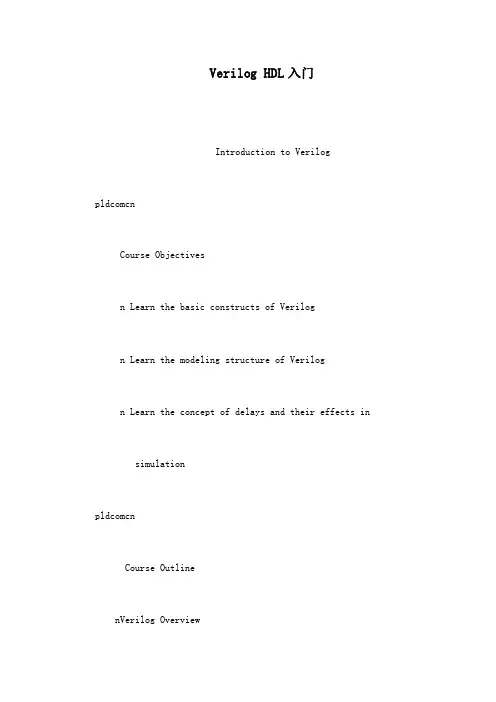
Verilog HDL入门Introduction to Verilog pldcomcnCourse Objectivesn Learn the basic constructs of Verilogn Learn the modeling structure of Verilogn Learn the concept of delays and their effects in simulationpldcomcnCourse OutlinenVerilog Overviewn Basic Structure of a Verilog Modeln Components of a Verilog Module– Ports– Data Types– Assigning Values and Numbers– Operators– Behavioral ModelingContinuous AssignmentsProcedural Blocks– Structural Modelingn Summary Verilog EnvironmentpldcomcnVerilogOverviewpldcomcnWhat is Verilogn IEEE industry standard Hardware DescriptionLanguage HDL - used to describe a digital system n For both Simulation SynthesispldcomcnVerilog Historyn Introduced in 1984 by Gateway Design Automationn 1989 Cadence purchased Gateway Verilog-XLsimulatorn 1990 Cadence released Verilog to the publicn Open Verilog International OVI was formed to control the language specificationsn 1993 OVI released version 20n 1993 IEEE accepted OVI Verilog as a standard Verilog 1364pldcomcnVerilog StructurenVerilog HDL Consists of Keywords syntax andsemantics used to describe hardware functionality and timingn PLI Programming Language Interface provides Clanguage routines used to interact between Verilog and EDA tools SimulatorsWaveform displaysn SDF Standard Delay Format - a file used to back-annotate accurate timing information to simulators and other toolspldcomcnTerminologyn HDL - Hardware Description Language is a softwareprogramming language that is used to model a piece of hardwaren Behavior Modeling - A component is described by itsinputoutput responsen Structural Modeling - A component is described byinterconnecting lower-level componentsprimitives pldcomcnBehavior Modelingn Only the functionality of the circuit no structure n No specific hardware intentn For the purpose of synthesis as well as simulationoutput 1 outputninput 1 inputnif input 1for j 0 j 8 j j25 output 1 1b0elsefor j 1 j 8 j j25 output 1 1b1pldcomcnStructural Modelingn Functionality and structure of the circuitn Call out the specific hardwaren For the purpose of synthesisHigher-level Componentinput1 output 1Lower-levelComponent1Lower-levelComponent1inputnoutputnpldcomcnMore Terminologyn Register Transfer Level RTL - A type of behavioralmodeling for the purpose of synthesis– Hardware is implied or inferred– Synthesizablen Synthesis - Translating HDL to a circuit and thenoptimizing the represented circuitn RTL Synthesis - The process of translating a RTLmodel of hardware into an optimized technologyspecific gate level implementationpldcomcnRTL Synthesisalways a or b or c or d or sel ainferredbegin b mux_outcase sel c2b00 mux_out a d2b01 mux_out b sel2b10 mux_out c 22b11 mux_out dendcaseaTranslationdaOptimization dpldcomcnVerilog vs Other HDL StandardsnVerilog– Tell me how your circuit should behave and I will give youthe hardware that does the jobnVHDL– Similar to VerilognABEL PALASM AHDL– Tell me what hardware you want and I will give it to youpldcomcnVerilog vs Other HDL StandardsnVerilog– Give me a circuit whose output only changes when there isa low-to-high transition on a particular input When thetransition happens make the output equal to the input untilthe next transition–Result Verilog Synthesis provides a positive edge-triggeredflipflopnABEL PALASM AHDL– Give me a D-type flipflop– Result ABEL PALASM AHDL synthesis provides a D-typeflipflop The sense of the clock depends on the synthesistoolpldcomcnTypical Synthesis Design FlowVerilog TechnologyModel LibrarySynthesisCompilerTiming Analysis Netlist PlaceRouteText OutputTestSimulationVectorsWaveformpldcomcnTypical Simulation Design FlowVerilog VerilogModelTestBenchOptionalSimulationCompilerSimulation TestModel VectorsWaveform Verilog Text OutputSimulationpldcomcnVerilogModelingpldcomcnVerilog - Basic Modeling Structuren CASE-sensitvemodule module_name port_list nAll keywords areport declarations lowercasenWhitespace is used fordata type declarations readabilitynSemicolon is thecircuit functionality statement terminatornSingle line commenttiming specifications n Multi-line commentendmodule nTiming specification isfor simulationpldcomcnComponents of a Verilog ModulemoduleTiming SpecificationsPort ListPort Data Type Circuit SubprogramsDeclarations Declarations FunctionalityInstantiation taskinput NetContinuous Procedural functionoutput Register Assignment BlocksSystem Tasksinout parameter assign initialblockCompilerDirectivesalwaysblockpldcomcnComponents of a Verilog Modulemodule Module_name Port_listPort declarations if ports are presentParameters optionalData type declarationsContinuous Assignments assignProcedural Blocks initial andalways- behavioral statementsInstantiation of lower-level modulesTasks and FunctionsTiming SpecificationsendmodulepldcomcnSchematic Representation - MACadder_outoutinaD Qmult_out clkXinbclr CLRNpldcomcnVerilog Model Mulitiplier-Accumulator MACtimescale 1 ns 10 ps assign adder_out mult_out outmodule mult_acc out ina inb clk clr alwaysposedge clk or posedge clrbegininput [70] ina inb if clrinput clk clr out 16h0000output [150] out elseout adder_outwire [150] mult_out adder_out endreg [150] outmulta u1 in_a ina in_b inb m_out mult_outparameter set 10parameter hld 20 specify setup ina posedge clk sethold posedge clk ina hldsetup inb posedge clk sethold posedge clk inb hldendspecifyendmodulepldcomcnLets take a look atmoduleTiming SpecificationsPort ListPort Data Type Circuit SubprogramsDeclarations Declarations FunctionalityInstantiation taskinput NetContinuous Procedural functionoutput Register Assignment BlocksSystem Tasksinout parameter assign initialblock CompilerDirectivesalwaysblockpldcomcnPortsn Port List– A listing of the port names– Examplemodule mult_acc out ina inb clk clr n Port Types– input -- input port– output -- output port– inout -- bidirectional portn Port Declarations–– Exampleinput [70] ina inbinput clk clroutput [150] outpldcomcnPorts List and Declarationtimescale 1 ns 10 ps assign adder_out mult_out outmodule mult_acc out ina inb clk clr always posedge clk or posedge clrbegininput [70] ina inb if clrout 16h0000input clk clr elseoutput [150] out out adder_outendwire [150] mult_out adder_outreg [150] out multa u1 in_aina in_b inb m_out mult_outparameter set 10 specifyparameter hld 20 setup ina posedge clk sethold posedge clk ina hldsetup inb posedge clk sethold posedge clk inb hldendspecify endmodule pldcomcnData Typesn Net Data Type - represent physical interconnect betweenprocesses activity flowsprocess processFunctional Functionalnets nets nets Block BlockMUX Addersnets netsnRegister Data Type - represent variable to store datatemporarily– It does not represent a physical hardware registerTemporary StoragepldcomcnNet Data Typenwire -- represents a nodentri -- represents a tri-state node n Bus Declarations– [MSB LSB ]– [LSB MSB]n Examples– wire– wire [150] mult_out adder_outpldcomcnNet Data TypesSupported byNet Data Type Functionality Synthesiswire tri Used for interconnectsupply0 supply1 Constant logic valuewand triand Used to model ECLwor trior Used to model ECLtri0 tri1 Pull-down Pull-uptrireg Stores last value whennot drivenpldcomcnRegister Data Typesnreg - unsigned variable of any bit size ninteger - signed variable usually 32 bits n Bus Declarations– [MSB LSB ]– [LSB MSB]n Examples– reg– reg [7 0] outpldcomcnRegister Data TypesRegisterSupported byData Type Functionality Synthesisreg Unsigned variable ofany bit sizeinteger Signed variable -usually 32 bitstime Unsigned integer -usually 64 bitsreal Double precisionfloating point variablepldcomcnMemorynTwo dimensional register arrayn Can not be a net typen Examplesreg [310] mem[01023] 1Kx32 reg [310] instrinstr mem[2]n Double-indexing is not permittedinstr mem[2][70] Illegal pldcomcnParametern Parameter - assigning a value to a symbolic nameparameter size 8reg [size-10] a bpldcomcnData Typen Every signal which includes ports must have a datatype– Signals must be explicitly declared in the data type declarations of your module– Ports are by default wire net data types if theyare not explicitly declaredpldcomcnData Types Declarationtimescale 1 ns 10 ps assignadder_out mult_out outmodule mult_acc out ina inb clk clr alwaysposedge clk or posedge clrbegininput [70] ina inb if clrinput clk clr out 16h0000output [150] out elseout adder_outwire [150] mult_out adder_out endreg [150] out multa u1 in_aina in_b inb m_out mult_outparameter set 10 specifyparameter hld 20 setup ina posedge clk sethold posedge clk ina hldsetup inb posedge clk sethold posedge clk inb hldendspecifyendmodule pldcomcnAssigning Values - NumbersandOperatorspldcomcnAssigning Values - NumbersnAre sized or unsized– Sized example 3b010 3-bit wide binary number The prefix 3 indicates the size of number– Unsized example 123 32-bit wide decimal number by defaultDefaults– No specified defaults to decimal–No specified defaults to 32-bit wide numbern Base Format–Decimal d or D 16d255 16-bit wide decimal number– Hexadecimal h or H 8h9a 8-bit wide hexadecimal number– Binary b or B b1010 32-bit wide binary numer– Octal o or O o21 32-bit wide octal numberpldcomcnNumbersn Negative numbers - specified by putting a minus sign beforethe– Legal -8d3 8-bit negative number stored as 2s complement of 3– Illegal 4d-2 ERRORn Special Number Characters– _ underscore used for readabilityExample 32h21_65_bc_fe 32-bit hexadecimal number– x or X unknown valueExample 12h12x 12-bit hexadecimal number LSBs unknown– z or Z high impedance valueExample 1bz 1-bit high impedance numberpldcomcnNumbersn Extended– If MSB is 0 x or z number is extended to fill MSBs with 0 xorz respectivelyExamples 3b01 3b001 3bx1 3bxx1 3bz 3bzzz– If MSB is 1 number is extended to fill MSBs with 0Example 3b1 3b001pldcomcnShort Quizn Short Quiz– Q What is the actual value for 4d017 in binary pldcomcnAnswersn Short Quiz– Q What is the actual value for 4d017 in binary– A 4b0001 MSB is truncated 10001pldcomcnArithmetic OperatorsOperator Operation ExamplesSymbol Performed ain 5 bin 10 cin 2b01 din 2b0ZAdd bin cin 11- Subtract Negate bin - cin 9 -bin -10Multiply ain bin 50Divide bin ain 2Modulus bin ain 0nTreats vectors as a whole valuen If any operand is Z or X then the results are unknown– Example ain din unknownn If results and operands are same size then carry is lostpldcomcnBitwise OperatorsOperator Operation ExamplesSymbol Performed ain 3b101 bin 3b110 cin 3b01XInvert each bit ain is 3b010And each bit ain bin is 3 b100 bin cin is 3b010Or each bit ain bin is 3b111Xor each bit ain bin is 3 b011or Xnor each bit ain bin 3b100n Operates on each bit of the operandn Result is the size of the largest operandn Left-extended if sizes are differentpldcomcnReduction OperatorsOperator Operation ExamplesSymbol Performed ain 5b10101 bin 4b0011cin 3bZ00 din 3bX011And all bits ain 1b0 din 1b0Nand all bits ain 1b1Or all bits ain 1b1 cin 1bXNor all bits ain 1b0Xor all bits ain 1b1or Xnor all bits ain 1b0n Reduces a vector to a single bitnX or Z are considered unkown but result maybe a knownvalue– Example din results in 1b0pldcomcnRelational OperatorsOperator Operation ExamplesSymbol Performed ain 3b010 bin 3b100 cin 3b111。
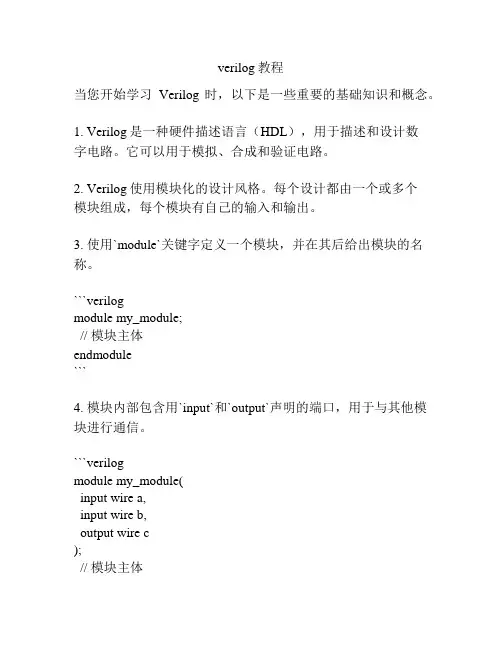
verilog教程当您开始学习Verilog时,以下是一些重要的基础知识和概念。
1. Verilog是一种硬件描述语言(HDL),用于描述和设计数字电路。
它可以用于模拟、合成和验证电路。
2. Verilog使用模块化的设计风格。
每个设计都由一个或多个模块组成,每个模块有自己的输入和输出。
3. 使用`module`关键字定义一个模块,并在其后给出模块的名称。
```verilogmodule my_module;// 模块主体endmodule```4. 模块内部包含用`input`和`output`声明的端口,用于与其他模块进行通信。
```verilogmodule my_module(input wire a,input wire b,output wire c);// 模块主体endmodule```5. `wire`关键字用于声明连接不同模块的导线。
可以将导线看作是用于传输数字信号的线。
6. 在模块主体中,可以使用`assign`关键字创建逻辑连接。
逻辑连接使用`=`运算符连接输入和输出。
```verilogmodule my_module(input wire a,input wire b,output wire c);assign c = a & b;endmodule```7. 除了逻辑连接外,可以在模块内部使用`always`块创建组合和时序逻辑。
```verilogmodule my_module(input wire a,input wire b,output wire c);reg d;always @(a or b)d = a | b;assign c = d;endmodule```8. Verilog还支持使用`if-else`语句,`case`语句和循环结构等常见的编程结构。
9. 为了模拟和验证设计,可以使用Verilog仿真工具,如ModelSim、VCS等。


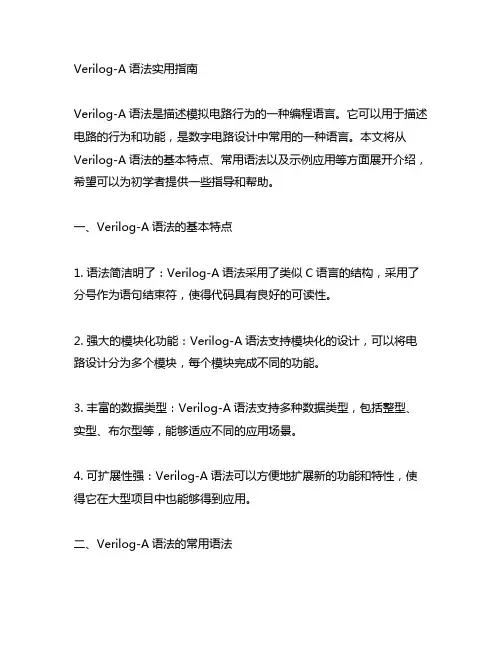
Verilog-A语法实用指南Verilog-A语法是描述模拟电路行为的一种编程语言。
它可以用于描述电路的行为和功能,是数字电路设计中常用的一种语言。
本文将从Verilog-A语法的基本特点、常用语法以及示例应用等方面展开介绍,希望可以为初学者提供一些指导和帮助。
一、Verilog-A语法的基本特点1. 语法简洁明了:Verilog-A语法采用了类似C语言的结构,采用了分号作为语句结束符,使得代码具有良好的可读性。
2. 强大的模块化功能:Verilog-A语法支持模块化的设计,可以将电路设计分为多个模块,每个模块完成不同的功能。
3. 丰富的数据类型:Verilog-A语法支持多种数据类型,包括整型、实型、布尔型等,能够适应不同的应用场景。
4. 可扩展性强:Verilog-A语法可以方便地扩展新的功能和特性,使得它在大型项目中也能够得到应用。
二、Verilog-A语法的常用语法1. 模块定义:使用module关键字定义一个模块,模块内包含输入端口、输出端口以及内部逻辑。
2. 参数定义:使用parameter关键字定义参数,可以在模块中使用这些参数。
3. 时序控制:使用initial关键字定义初始条件,使用always关键字定义条件触发的操作。
4. 信号赋值:使用assign关键字完成信号之间的赋值操作。
5. 行为描述:使用initial和always关键字描述电路的行为。
6. 分支结构:使用if...else...语句完成条件判断。
7. 循环结构:使用for和while等关键字完成循环操作。
三、Verilog-A语法的示例应用1. 模拟电路设计:Verilog-A语法可以用于模拟电路的设计和验证,包括数字电路和模拟电路。
2. 信号处理:Verilog-A语法可以用于实现信号的采集、处理和输出。
3. 控制系统:Verilog-A语法可以用于描述控制系统的行为和功能,包括PID控制、状态空间控制等。
4. 通信系统:Verilog-A语法可以用于描述通信系统的行为和功能,包括调制解调、编解码等。
verilog语⾔⼊门教程module a(b, c, d,...z);//module: 模块头 a:模块名(b,c,d,...z):端⼝列表input b;//输⼊声明input wire c;//输⼊声明线⽹类型⽤wire,wire可省略input wire [7:0] d;//[7:0]:输⼊总线位宽0~7所以是8bit总线output e;//输出声明output [7:0] f;//输出总线位宽说明,默认为wire类型,此处省略wireoutput reg [7:0] f;//输出总线寄存器类型⽤reg ...//为了篇幅⼩⼀些省略e~y的声明,实际代码中不可省略assign d = a & b;//assign语句也叫数据流建模语句也叫连续赋值语句,后⾯接的是组合逻辑assign e = (f < g)? 1 : 0;//三⽬运算符always @ (posedge a or negedge b or posedge c...)//always语句,posedge为上升沿触发,negedge为下降沿触发,后⾯接信号表⽰当这个信号上升沿或下降沿时执⾏下⾯的程序begin//begin...end 相当于()if(!b)//if语句beginh <= 4'b0000;//⾮阻塞赋值语句⽤<=,4'b0000表⽰位宽为4,⼆进制表⽰的数0000i <= 32'haabbccdd;//此处表⽰32位宽,16进制表⽰的数aabbccddendelse//else表⽰分⽀case(j)//case语句0 : k <= k + 1'b1;//verilog中没有⾃加的表⽰,所以⽤k = k + 1'b11 : if(k<m) begin l <= 8'd7;j <= 2; end// j <= 2表⽰下⼀个时钟沿触发后跳到2:语句2 : m < = 4'b0001 << 2;//<<移位符号default: j <=0; //default语句表⽰当j取值不是上⾯列出的0,1,2时⾛这条语句endcase//case多路分⽀语句结束标志end//整个always循环结束标志endmodule//整个模块结束标志。
Verilog语法简易教程Verilog是硬件描述语言(HDL)之一,主要用于硬件设计和仿真。
它于1984年由一家名为Gateway Design Automation的公司开发,并于1985年推出。
Verilog以其简单易学的语法和强大的功能而闻名于世。
本简易教程将向您介绍Verilog的基本语法和常用结构。
它包括模块化设计,数据类型,运算符,条件语句,循环语句和时序建模等内容。
首先,让我们先来了解Verilog中的模块化设计。
在Verilog中,设计是通过定义和连接模块来完成的。
每个模块由输入输出端口和内部逻辑组成。
以下是一个简单的Verilog模块的例子:```module adder(input [3:0] A, B, output [3:0] sum);assign sum = A + B;endmodule```上述代码定义了一个名为adder的模块,它具有两个输入端口A和B,以及一个输出端口sum。
内部逻辑通过assign语句实现,将输入端口A和B相加,并将结果赋值给输出端口sum。
接下来,让我们了解Verilog中的数据类型和运算符。
Verilog支持多种数据类型,包括位向量(bit vector)、整数(integer)、浮点数(real)等。
其中,位向量是最常用的数据类型。
以下是两个位向量相加的例子:```module adder(input [3:0] A, B, output [3:0] sum);assign sum = A + B;endmodule```在这个例子中,输入端口A和B都是4位的位向量,输出端口sum也是4位的位向量。
通过使用+运算符,我们可以对这两个位向量进行相加操作,并将结果赋值给输出端口sum。
除了基本的数据类型和运算符,Verilog还提供了丰富的条件和循环语句。
条件语句允许您在程序中根据一些条件执行不同的操作。
以下是一个简单的条件语句的例子:```beginif (A == B)equal = 1;elseequal = 0;endendmodule```在这个例子中,我们使用了always块来定义一个连续的行为。
?Verilog-A 30分钟快速入门教程
进入正题,学了几天的Verilog-A,平台是Agilent ADS,主要参考
“ Verilog- AMS Language Reference Manual”和ADS的帮助文档。
现在的状态算是入门了,写了个简单的PLL。
总结这几天的学习,觉得效率太低,我以前有一定 Verilog 基础,研一时学过一点 VHDL-AMS ,学到现在这个状态应该
半天就够了;入门的话, 30 分钟足矣;跟着这个教程走,你会很快了解和熟悉Verilog-A 。
(前提是有一定的 Verilog 基础和电路基础)
1、基尔霍夫定律撑起了整个电路学的大厦(当然也可以认为基尔霍夫定律只是
麦克斯韦方程的简化版),作为模拟电路描述语言 Verilog-A ,同样将基尔霍夫定律作为其基本,最重要的两个概念便是流量 (Flow) 和位 (Potential) ,在电学里是电流
和电压,在力学里可以是力和距离,在热学里可以是功率和温差,等等。
在 Verilog-A中,你可以将电阻电容电感等器件用一个方程式来表述,比如
I(out) <+ V(out)/R ,这样就产生了一个电阻,最后 Verilog-A 仿真器会用某种算法( 迭代是最常见的 ) 将 I(out) 和 V(out) 求解出来,然后根据这个解去算下一个时刻
的 I 、V 等,当然这仅仅是指时域仿真。
2 、下面讲Verilog-A的语法:
begin end //相当于C语言的一对大括号,与Verilog
同
if ( expression ) true_statement ;
[ else false_statement ; ] //与Verilog同
case ( expression ) case_item { case_item } endcase
for ( procedural_assignment ; expression;
procedural_assignment ) statement
//case与for语句都跟Verilog、C语言类似
cross( expr [, dir [, time_tol [, expr_tol ]]] );
//cross 用来产生一个 event ,如:
@(cross(V(sample) -2.0, +1.0))
//指 sample 的电压超过 2.0 时触发该事件,将会执行后面的语句, +1.0 表示正向
越过, -1.0 则相反
ddt( expr )// 求导,如:
I(n1,n2) <+ C * ddt(V(n1, n2)); //表示了一个电容
idt( expr ,[ ic [, assert [, abstol ]]] ) //积分,如:
V(out) <+ gain * idt(V(in) ,0) + gain * V(in);
// 比例积分,式中的 0 表示积分的初值
transition( expr [, time_delay [, rise_time [, fall_time [, time_tol ]]]] )
// 将 expr 的值 delay一下并指定上升下降沿时间,相当于一个传输门
laplace_zp( expr ,ζ ,ρ)
将 expr 进行拉普拉斯变换,具体表达式参看相关文献,还有laplace_zd()等
数据类型:
integer 、real ,另外就是 discipline ,不知道怎么翻译比较好,比如说它将电压
电流这两个 nature 类型作为一个 discipline ,这些都在 disciplines.vams
这个头文件里建好了,编程时要`include "disciplines.vams"。
如果要定义一个电路节点, electrical node_name就好了
parameter {real | integer} list_of_assignments ;
// 定义参数,如 parameter R = 50 from (0:inf];
在一个模块中调另一个模块和Verilog差不多,如:
blk_a a1(Input1, a_b1);
blk_a a2(Input2, a_b2);
运算符号:
+ - * / > < == & | && || ^ << >> ?:等,跟Verilog一样
另外,新加的一个符号 <+ ,这个专门给模拟信号赋值用,注意这个赋值符号是
可以累加的,就是说赋两次值的话,它会加起来,而不是覆盖,如:
// model input admittance(导纳)
I(in) <+ V(in)/Rin;
I(in) <+ Cin*ddt(V(in));
预处理 & 宏:
`define`else`ifdef`include`resetall`undef
跟 Verilog 差不多
3 、Verilog-A程序基本结构:
`include "disciplines.vams"// 预处理
module load(p);// 定义模块, p 是端口
electrical p, gnd;// 定义节点
ground gnd;// 定义 gnd 为 ground节点,电位为0
parameter real R=50.0;// 定义 R 这个参数并赋初值
analog// 模拟语句从这开始
V(p) <+ R * I(p, gnd);// 在这里表示一个电阻,表示了输出电压与输出电流的关系
endmodule// 模块定义结束
4 、上面这些基本上是最常用的了,了解之后,你就能看懂一般的Verilog-A 程序了,下面是我写的PLL 仿真程序,把它看完并看懂(当然第一次并不需要看得很仔细):
提示:振荡频率 4~6G ,分频器为 50 分频,Fref 为 100M ,鉴相器为电荷泵型。
`include "disciplines.vams"
`include "constants.vams"
//VCO
module my_vco(in, out);
input in;
output out;
electrical in, out;
parameter real gain=2.0e9, fc=4.0e9;
analog
V(out) <+ sin(2*`M_PI*(fc*$realtime + idt(gain*V(in))));
endmodule
//phase detector
module my_pd(ref,rf,outP,outN);
input ref,rf;
output outP,outN;
electrical ref,rf,outP,outN;
real clr,up,down;
parameter real Ro=1e6, Ro2=1;
analog begin
@(cross(V(ref)-0.5,+1))
up = 1;
@(cross(V(rf)-0.5,+1))
down = 1;
clr = absdelay(up && down, 1e-9);
// clr = transition(up && down, 1e-9); // 这两条语句都可以 if(clr>0.5) begin
up = 0;
down = 0;
end
if(up) begin
if(V(outP)>= 3)
V(outP) <+ 3-I(outP)*Ro2;
else I(outP) <+ -up*0.01;
end
else begin
I(outP) <+ 0;
end
if(down) begin
if(V(outN) <= 0)
V(outN) <+ 0-I(outN)*Ro2;
else I(outN) <+ down*0.01;
end
else begin
I(outN) <+ 0;
end
end
endmodule
//N divider
module my_divider(in,out);
input in;
output out;
electrical in,out;
integer cnt;
parameter integer K=50;
analog begin
@(cross(V(in),+1))
cnt = cnt+1;
if(cnt>=K)
cnt=0;
if(cnt*2-K>=0)
V(out) <+ 1;
else
V(out) <+ 0;
end
endmodule
以上是 VCO 、鉴相器和分频器,原理图我是在ADS 中画的,如下所示:
以下是仿真结果:
好,看到这儿你已经入门了,想进一步熟悉Verilog-A的话,请参看:。